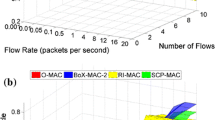Abstract
Applications for wireless sensor networks have notably different characteristics and requirements from standard WLAN applications. Low energy consumption is the most important consideration. The low message rate that is typical for sensor network applications and the relaxed latency requirements allow for significant reductions in energy consumption of the radio. In this article we study the energy saved by two MAC protocols optimized for wireless sensor networks, S-MAC and T-MAC, in comparison to standard CSMA/CA, We also report on the effects of low-power listening, a physical layer optimization, in combination with these MAC protocols. The comparison is based on extensive simulation driven by traffic that varies over time and location; sensor nodes are inactive unless they observe some physical event, or send status updates to the sink node providing the connection to the wired world. T-MAC} in combination with low-power listening saves most energy, but can not handle the same peak loads as CSMA/CA and S-MAC.
Similar content being viewed by others
References
I. Akyildiz, W. Su, Y. Sankarasubramaniam and E. Cayirci, A survey on sensor networks, IEEE Communications Magazine 40(8) (2002) 102–114.
V. Bharghavan, A. Demers, S. Shenker and L. Zhang, MACAW: A media access protocol for wireless LAN’s, in: Conf. on Communications Architectures, Protocols and Applications (London, August 1994) pp. 212–225.
T. van Dam and K. Langendoen, An adaptive energy-efficient MAC protocol for wireless sensor networks, in: 1st ACM Conf. on Embedded Networked Sensor Systems (SenSys 2003), (Los Angeles, CA, November 2003) pp. 171–180.
J. Hill and D. Culler, Mica: A wireless platform for deeply embedded networks, IEEE Micro 22(6) (2002) 12–24.
J. Kahn, R. Katz and K. Pister, Next century challenges: Mobile networking for “Smart Dust”, in: 5th ACM/IEEE Int. Conf. on Mobile Computing and Networks (Mobicom ‘99), (Seatle, WA, August 1999) pp. 271–278.
A. Mainwaring, J. Polastre, R. Szewczyk, D. Culler and J. Anderso, Wireless sensor networks for habitat monitoring, in; First ACM Int. Workshop on Wireless Sensor Networks and Application (WSNA) (Atlanta, GA, September 2002) pp. 88–97.
LAN MAN Standards Committee of the IEEE Computer Society, IEEE Std 802.11–1999, Wireless LAN Medium Access Control (MAC) and Physical Layer (PHY) specifications. IEEE, 1999.
RFM, TR1001 868.35 MHz Hybrid Tranceiver.
S. Singh and C. Raghavendra, PAMAS: Power aware multi-access protocol with signalling for ad hoc networks, ACM SIGCOMM Computer Communication Review 28(3) (1998) 5–26.
Texas Instruments, MSP430x1xx Family User’s Guide. SLAU049B.
Y. Tseng, C. Hsu and T. Hsieh, Power-saving protocols for IEEE 802.11-based multi-hop ad hoc networks, in: 21st Conf. of the IEEE Computer and Communications Societies (INFOCOM) 1 (June 2002) vol. 1, pp. 200–209.
A. Varga, The OMNeT++ discrete event simulation system, in: European Simulation Multiconference (ESM’2001) (Prague, Czech Republic, June 2001).
W. Ye, J. Heidemann and D. Estrin, An energy-efficient MAC protocol for wireless sensor networks, in: 21st Conference of the IEEE Computer and Communications Societies (INFOCOM), 3 (June 2002) vol. 3, pp. 1567–1576.
W. Ye, J. Heidemann, and D. Estrin, Medium access control with coordinated, adaptive sleeping for wireless sensor networks. IEEE/ACM Trans. on Networking 12(3) (2004) 493–506.
Author information
Authors and Affiliations
Corresponding author
Additional information
Gertjan Halkes earned a B.Sc. and an M.Sc. in computer science from the Delft University of Technology in 2002 and 2004 respectively. He is currently working as a Ph.D. student in the Parallel and Distributed Systems group at that same university.
Tijs van Dam received an M.Sc. in computer science from Delft University of Technology, The Netherlands in 2004. He is now working for IBM.
Koen Langendoen is an associate professor in the Parallel and Distributed Systems group at Delft University of Technology, The Netherlands. He earned an M.Sc. in computer science from the Vrije Universiteit, Amsterdam in 1988 and a Ph.D. in computer science from the Universiteit van Amsterdam in 1993. His research interests include system software for parallel processing, wearable computing, embedded systems, and wireless sensor networks.
Rights and permissions
About this article
Cite this article
Halkes, G.P., van Dam, T. & Langendoen, K.G. Comparing Energy-Saving MAC Protocols for Wireless Sensor Networks. Mobile Netw Appl 10, 783–791 (2005). https://doi.org/10.1007/s11036-005-3371-x
Issue Date:
DOI: https://doi.org/10.1007/s11036-005-3371-x




